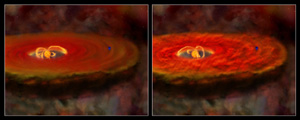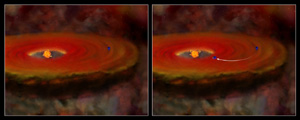Comments from Joan Najita
How can massive flares from young stars affect planet survival? As Joan Najita explains here, the answer lies in understanding what happens when planet-forming disks of gas and dust are hit by powerful X-rays.
The deep Chandra observations of Orion may play an important role in understanding the origin and survival of the Earth and Jupiter in our own solar system, and by extension, the many extrasolar giant planets discovered to date.
How Planets FormIn the case of our own solar system, one of the distinctive features of our solar system is that it includes both terrestrial planets, like the Earth, and giant planets, like Jupiter, in the same system. There is an attractive picture that describes why these two kinds of planets should coexist in the same system -- a picture that's known as the "core accretion" model.
In the core accretion model, the solar system arises from a disk of gas and dust grains (as shown here). The tiny grains grow through sticky collisions first into rocks, then larger rocks, and eventually rocky planetary cores. If the cores grow large enough through collisions, they can then accrete a gaseous envelope and end up as a giant planet, like Jupiter. If they don't grow to be that large, they end up as rocky terrestrial planets, like the Earth. So a natural outcome of this picture is the presence of terrestrial and giant planets in the same system.
Planet SurvivalA long-standing question regarding this picture is how it really works, why the Earth exists, and why it did not migrate inward long ago to merge with the Sun. That is to say, when planetary cores form, they form in a disk filled with gas. Traditionally, the gravitational interaction between the planetary cores and the gas is expected to cause the planetary core to lose angular momentum and spiral into the star on very short timescales, timescales much less than a million years.
How then did the Earth survive the much longer timescale of several millions of years that it took the for the gas in the disk to dissipate? Similarly, how did the core from which Jupiter formed survive long enough to accrete a gaseous envelope, a process that is believed to take several million years? The answer to these two related questions may lie in the turbulent nature of planet-forming disks. This right panel of this illustration shows an example of the lumpy fluctuations in a turbulent disk.
The Effects of TurbulenceWhile the idea that planet-forming disks may be turbulent is not particularly new, what is new is our understanding of the role that turbulence may play in determining the ultimate architectures of planetary systems. In contrast to a non-turbulent disk, where planetary cores are expected to undergo a rapid inspiral into the star as shown in this illustration, in a turbulent disk planetary cores will scatter off turbulent fluctuations, like boats tossed about by waves in a storm. As a result, planetary cores are expected to execute a "random walk", which greatly increases the time it takes them to migrate away from their initial location.
This may effectively "preserve" terrestrial planets until the gas disk dissipates, so that they end up as a planet like the Earth. In the context of the core accretion model, this also gives giant planetary cores the time they need to accrete a gaseous envelope and end up as a giant planet like Jupiter. Turbulence may play a similar role in the formation of the extrasolar giant planets.
Did Super-flares Save the Earth?The Chandra observations play a role in supporting this picture by showing that the copious X-rays emitted by young stars interact with the disk, thereby ionizing the disk and possibly producing the critical electrons and ions that are needed for the disk to couple to the weak magnetic field that is expected to be present in the disk. These conditions - a rotating disk, the presence of electrons and ions, and a disk magnetic field - are the conditions that lead to the generation of turbulence.
What's interesting to me, from a human perspective, is that when solar flares are emitted by the Sun today, they are thought to be a danger or maybe just a nuisance, for example, in the sense that they might knock out our communication systems. So in some ways it's remarkable to think that such stellar flares, when they were emitted by the Sun in its youth, could have played a very important role in the survival of our planet.

Dr. Joan Najita is an Astronomer at the National Optical Astronomy Observatories. Her main research interests are in star formation and the formation and evolution of planetary systems.
Read more about Dr. Najita in her biography.

Return to Orion Nebula (10 May 05)







